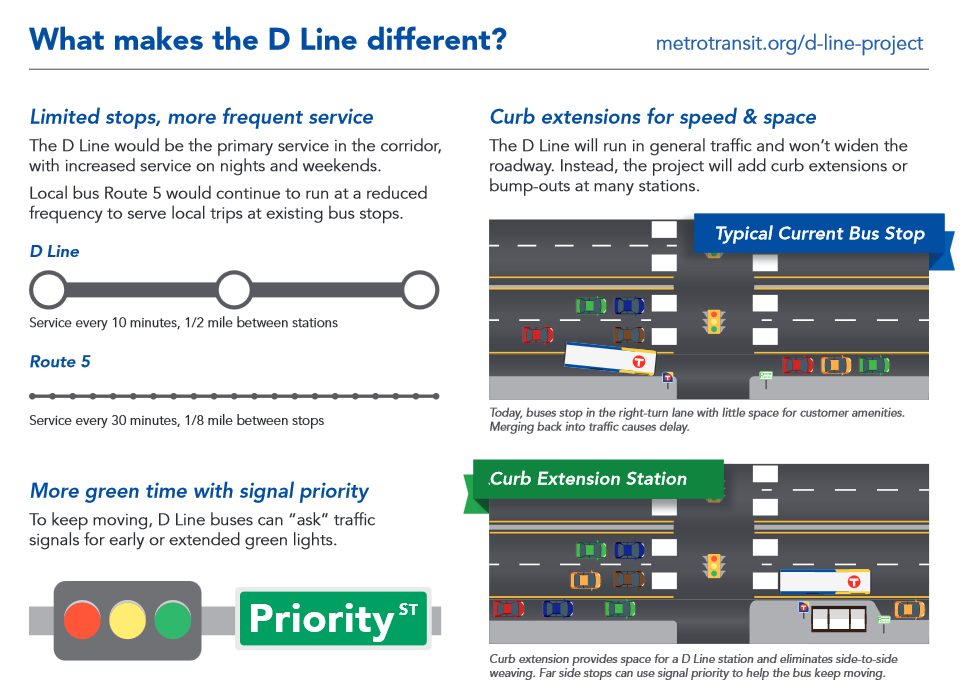To Build a More Equitable Transit System, Improve the Buses
There was some Big News last week when it came to light that, as part of security measures for the Super Bowl, the Blue Line and the cool part of the Green Line will be closed for one (1) Sunday in February. And boy howdy, people were pissed.
It is a fairly simple and easy to understand example of the wealthy taking priority over regular folks. I might argue that replacing part of the rail transit system with buses for a day is something that could happen when you host the nation's highest profile event, but who among us has not milked a Vikings stadium-adjacent controversy for attention by now?
Hey though, while we're on the subject on fancy rich people getting neat stuff while the rest of us languish on a second tier system, you should check out, ah, pretty much everything else about transit in the Twin Cities, and in particular what we've got on tap for the future.
For example, where do the Green Line extension ($1.9 billion 2017 USD) and Blue Line extension ($1.5 billion 2017 USD) go? Local cat owner Peter Bajurny threw together a map that puts some stuff into perspective, maybe:
You've got your blue and green lines out to the suburbs of Brooklyn Park and Eden Prairie, respectively. The yellow lines on there are planned arterial bus rapid transit (ABRT) lines, which are the best thing this region has thought of in an official capacity since the Green Line was greenlit in 2009 or so. They are conveniently located in areas where there are well-used (often past comfortable capacity!) bus routes, and those often travel through parts of the metro area where there are pockets of poverty.
ABRT is that thing that the A Line is, over on Snelling Avenue—basically a hugely improved local bus route. They are named after letters of the alphabet. It's faster than a regular bus due to transit signal priority, has amenities like nice shelters and real-time arrival information, and most importantly, it's cheap cheap cheap.
The C Line on Penn Avenue North is projected to have about 9,800 daily riders in 2030, and will cost about $32 million. The Green Line extension is projected to have about 28,100 daily riders in 2030, and it is currently budgeted at $1.9 billion. Three times the ridership, 60 times the cost, baby. The C Line will be faster than the existing Route 19 bus, while the Green Line will take longer to wind its way into downtown Minneapolis than the existing express buses from the southwest metro. It cannot be stated enough that this is extremely cool and that everything is going very well, around here.
Even more wild than that is that those remaining planned ABRT lines on Chicago, Emerson/Fremont, Hennepin, Nicollet, and Central Avenues and Lake, Robert, and East 7th Street are...not funded! This, even though they are incredibly cheap in comparison to the two light rail extensions, are in effect actual transit improvements (they make the transit part of transit work better (they are faster and better than the existing bus)), and serve the people in our region who need better service because their livelihoods and lives depend on transit.
It is often suggested that there is not money for nice things around here, which is sometimes true, but you do often hear it from the same 100 sycophants who are trying to get the same eight jobs. I would argue that there is plenty of money floating around, around this here metropolitan area.
For example, you may have heard of a fairly major recent change in transit funding mechanisms, where the Counties Transit Improvement Board was disbanded, and Hennepin and Ramsey Counties voted to raise their respective transit sales taxes. It is projected to bring in a whopping additional $65 million per year in Hennepin County alone. That's some money. Where is that money gonna go? Probably to building a tunnel under a bike trail in the Kenilworth Corridor and bridges over suburban highways and wetlands for the Green Line extension, not to mention all the to-be-discovered stuff lurking in marshes where we put the Blue Line extension.
The big trains are the big thing, but there's also plenty of stuff going on in the tail-ends of Powerpoint presentations in conference rooms that barely makes the news. The $6.45 million for an east metro park and ride with five users, $4.6 million for an unnecessary pedestrian bridge for Vikings fans, $15 million for a freeway station on the empty Red Line, or millions for suburb-to-suburb bus routes that even simpletons can see won't work out.
This all adds up. There is money out there. Political decisions made by people who don't take the bus figure heavily into all of these things. Ramsey County spent $200 million in transit money to renovate Union Depot into...frankly, an event space. That reopened in 2011, the same year the East 7th Street and Robert Street ABRT lines combined were projected to cost $46 million to improve service for 20,300 daily riders. They are still not funded, six years later. That's a decision that got made. We could make future decisions differently.
Can you believe this isn't funded? Check out Metro Transit's website for more information
For a region that has moved heaven and earth over the past decade to attempt to spend almost $2 billion on the Green Line extension to replace coach buses for suburbanites with a slower train, we absolutely should be able to pull together a couple hundred million dollars to improve our bus routes. Across the system, we're still carrying 60% of riders on the regular ole bus. Crowded, slow local bus routes in Whittier and North Minneapolis and St. Paul’s East Side may have proportionately fewer "choice" riders—because they are literally dependent on transit service—but they still deserve investment.







